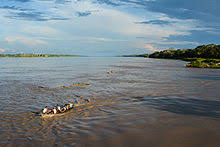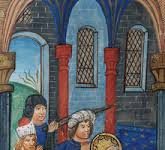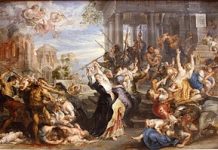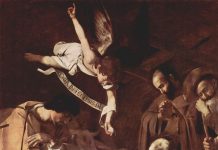Saint Anthony Zaccaria (+1539), from noble lineage in late-renaissance Italy, first studied medicine, then for the priesthood, adopting a life of great discipline and zeal, founding the ‘Barnabites’, inspired by the teachings of Saint Paul the Apostle, dedicated to renewing the Church and rooting out abuses. Hmm. He also popularized the ‘Forty Hours Devotion’ of continuous adoration, as well as ringing the church bells at 3 p.m. on Friday in remembrance of the crucifixion, which elides well with the future devotion to the Divine Mercy. All things are connected in God’s providence.
Ronald Coyne is a law student at venerable Cambridge University even if he be of the rather unvenerable age of ten and eight. On his way to or from a posh event, in coat and tails, it seems deliberately, and tauntingly, he set fire to a 20-pound note in front of a homeless man who had begged from him. Much could be said of this, but I recommend Theodore Dalyrymple’s take on the incident. As I mentioned recently, Dalyrymple’s real name is Anthony Daniel, a psychiatrist and an avowed atheist, but his analysis is trenchant. I always wonder if he has some incipient faith. Pray for him, and for Mr. Coyne.
And on trenchant truncheons, I had just heard of the savage beating of the reporter Andy Ngo by ‘Antifa’ elements. Mr. Ngo is apparently himself ‘gay’, and hardly displays fascist sympathies, but he does disagree with some ‘Antifa’ principles, insofar as they have any. Antifa stands for ‘anti-fascist’, even though, in their own idiotic lack of self-awareness, these masked, black-clad thugs act just like Mussolini’s similarly-clad blackshirts, bullying and beating, always in tribal groups, abiding by that ancient logical fallacy of the ad baculum, ‘to the stick’: That is, the best way to win an argument – especially one you are sure to lose – is to beat your opponent into submission. See Mark Steyn’s take on the ‘Klantifa’, who seem to have just swapped out the hoods, in more ways than one.
While on sticks and clubs, yesterday was the anniversary – forgive the kind associations of that word – of the burning of the Riga synagogues by Nazi troops and their sympathizers in the Latvian city. Details are disputed, but what is certain is that the demonic marauders shot, burned, killed and raped and pillaged to their lusts’ content. Thousands of Jewish people, men, women and children – and other ‘sympathizers’ – were dragged from their homes, out onto the streets or marched into the forests and shot in cold blood, others burned alive, locked inside their holy places of worship.
We may thank God that we have not (yet?) returned to such overt atrocities – prescinding from the hidden holocaust on the unborn – but we may ask whether America is on the brink of a civil war of some sort. Perhaps. These things are difficult to predict, as a perusal of the irenic thoughts and musings of various bright, incisive leaders on the very brink of historical horrific conflicts will attest. ‘Peace in our time’ and all that. Then again, some were privileged to see the signs in the sky, and all it takes is a spark to set off a conflagration.
Two quite different documents have been issued of late by the Vatican: On the good side, we have the recent Note from the Apostolic Penitentiary, which makes quite clear that, contrary to various laws being promulgated in California and elsewhere, priests must maintain the inviolable seal of the confessional, even to the point of shedding their blood, regardless of what they hear. I am glad to hear that Saint John Nepomucene (+1393) -the Queen’s confessor, tortured by the King to reveal her secrets (he thought she was having an affair) – did not die in vain.
Then we have the working document for the upcoming Amazonian Synod, about which you may read in various places, including this analysis from William Kirkpatrick, who claims that, in the midst of some traditional theology, the text overall is a half-baked Rousseaunian stew, the ‘noble savage’, the pure state of nature, and on it goes, in the minds of some even high up in the Church, in an eco-apocalytpic Teilhardian fantasy-land.
Father Raymond de Souza has his own, more ecclesiological and missiological take, concluding that the document seems to imply that the indigenous peoples are exempt from original sin, and, apparently, have little if any need for mission, or the Gospel of Christ. In fact, it is they who are a ‘locus of revelation’. One wonders. I don’t have the heart – if such be the right anatomical term – to read to plough through the text in great detail, but feel free if you have the proclivity, and if anyone has any thoughts, please do pass them along.
We must sift through the good, the bad, the ugly and indifferent, using the ‘tangle of our wits’, as Thomas More put it, to find our path to heaven. But all that we need to find that road is there, clear as day, for those with eyes to see.











